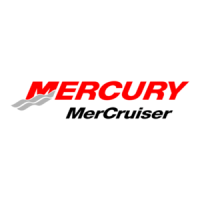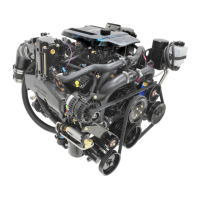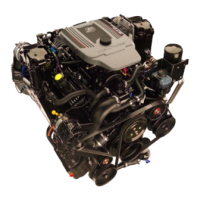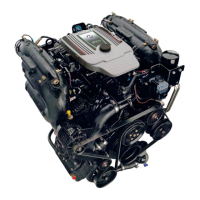53
CC186
Draining Instructions
DRAINING SEAWATER (RAW-WATER) COOLED MODELS
!
CAUTION
If boat is to remain in water after draining, seawater inlet hose must be removed and plugged to prevent
a siphoning action that may occur, allowing seawater to flow from the drain holes or removed hoses.
!
CAUTION
Seawater section of cooling system MUST BE COMPLETELY drained for winter storage, or immediately
after cold weather use, if the possibility of freezing temperatures exist. Failure to comply may result in
trapped water causing freeze and/or corrosion damage to engine.
1 Ensure engine is as level as possible to ensure complete draining of cooling system.
2 Remove drain plugs from cylinder block as follows:
A. Port Side - from cylinder block.
B. Starboard Side - from Y-fitting. Do not disturb the Y-fitting when removing the drain plug. There is an ignition
control “Knock Sensor” in the upper hole of the fitting. This sensor must not be loosened or removed. It is tight-
ened to a critical specification at the factory.
3 Remove drain plug from transmission cooler.
4 Remove the drain plugs from bottom of exhaust manifolds (port and stbd).
5 Repeatedly clean out drain holes using a stiff piece of wire. Do this until entire system is drained.
NOTE:
It may be necessary to lift or bend hoses to allow water to drain completely. Crank engine over slightly to
purge any water trapped in seawater pickup pump. Do not allow engine to start.
Loosen hose clamps and disconnect the following hoses:
6 From engine circulating pump.
7 From seawater pickup pump (both hoses).
After cooling system has drained completely, coat drain plug threads with Quicksilver Perfect Seal and reinstall
drain plugs. Reconnect hoses and tighten all hose clamps securely.
IMPORTANT: MerCruiser recommends that propylene glycol antifreeze (nontoxic and biodegradable,
which makes it friendly to lakes and rivers) be used in seawater section of the cooling system for cold
weather or extended storage. Make sure that the propylene glycol antifreeze contains a rust inhibitor and
is recommended for use in marine engines. Be certain to follow the propylene glycol manufacturer’s rec-
ommendations.
8 For additional assurance against freezing and rust, remove thermostat cover and thermostat. Fill engine seawa-
ter cooling system with a mixture of antifreeze and tap water mixed to manufacturer’s recommendation to protect
engine to the lowest temperature to which it will be exposed during cold weather or extended storage. Using a new
gasket, reinstall thermostat and cover. Tighten cover bolts securely.
Perform all checks, inspections, lubrication, and. fluid changes outlined in MAINTENANCE CHART under AT
LEAST ONCE A YEAR.

